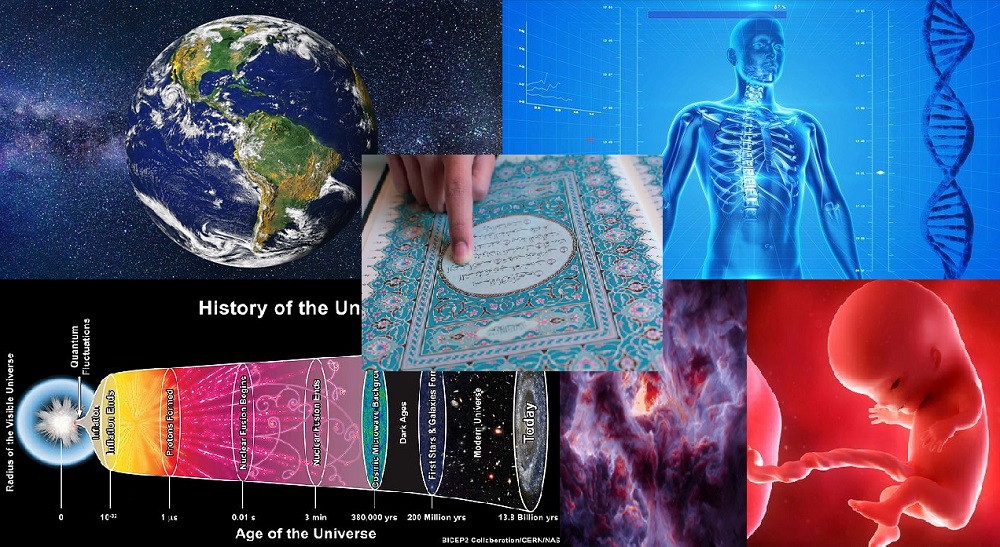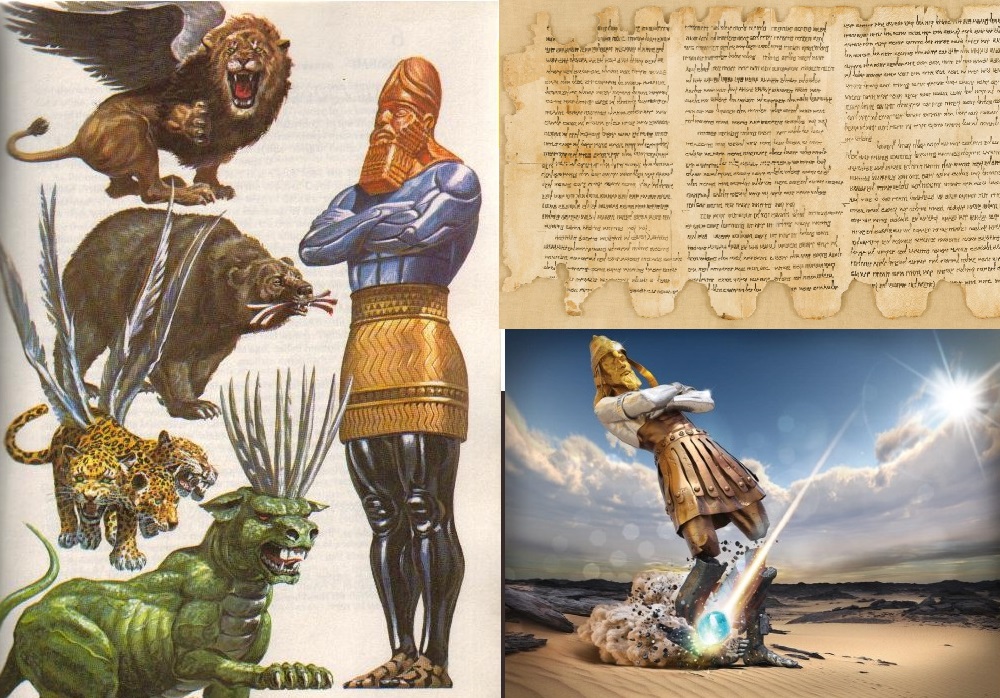Foretelling the Future: The Prophetic Miracles of Muhammad ﷺ
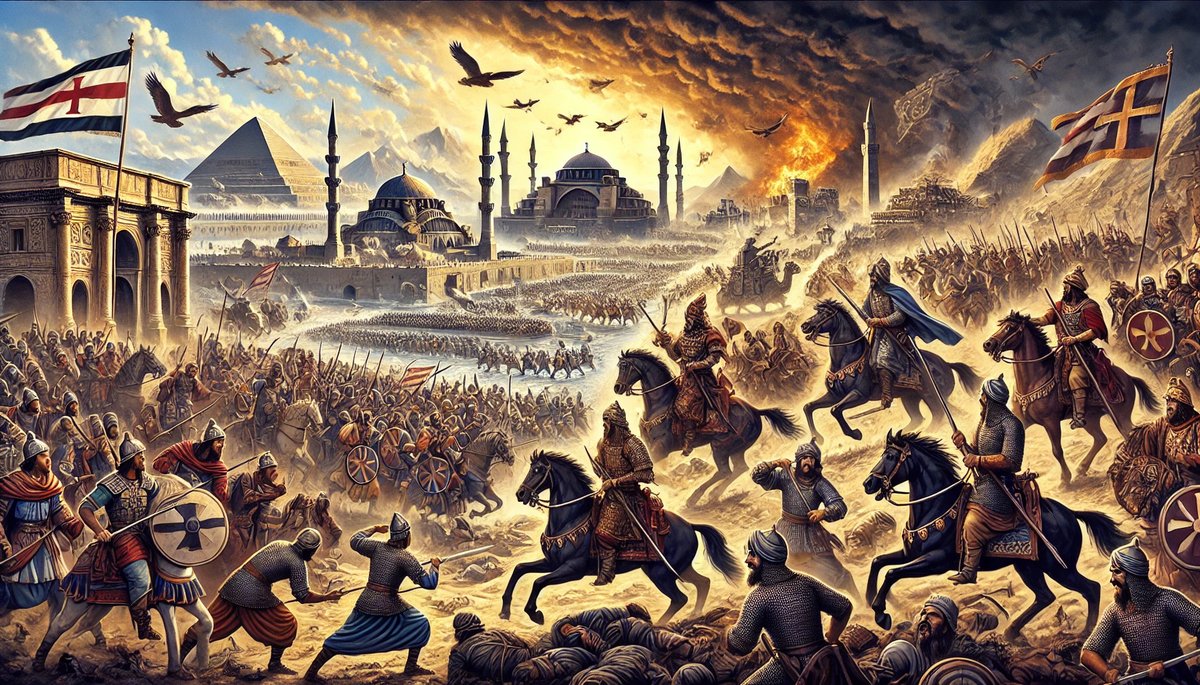
Some of the most powerful and convincing pieces of evidence of Muhammad(ﷺ) ‘s prophethood are the numerous instances where he accurately predicted future events. The Prophet ﷺ foretold many things that would happen to his community after his death. These events occurred exactly as Muhammad(ﷺ) stated.
In this article, we will delve into this vast ocean, exploring its marvels, specifically focusing on some of the events foretold by Prophet Muhammad(ﷺ) that stand as significant testimonies to his prophethood.
Prophecies of Prophet Muhammad(ﷺ) of Great Battles and conquests
Prophet Muhammad(ﷺ) foretold significant conquests that Muslims would achieve, predicting the expansion and success of the Muslim community in various regions.
Byzantine Victory over the Persians: A Miraculous Prophecy
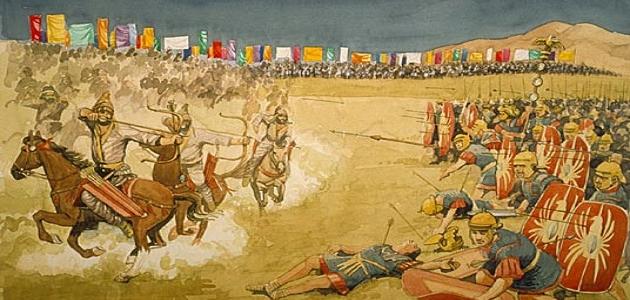
During the early 7th century, the world was dominated by two superpowers: the Byzantine Empire and the Persian Sassanid Empire. These empires engaged in a massive war, with the Sassanids decisively defeating the Byzantines between 613 and 619 CE and capturing vast territories. These included Byzantine Armenia, Syria, Palestine, Egypt, Libya, Anatolia, and even the revered True Cross artifact. The Byzantine Empire was on the brink of ruin, losing almost everything to the Persians.
In this dire context, the Quran made a bold and risky prophecy:
The term “bidh’u sinin” (a few years) used in the prophecy refers to a period of three to nine years. The prediction was that the Byzantines would make a comeback within this timeframe despite their seemingly insurmountable losses.
The prophecy carried significant risk. If the Byzantines did not recover within the specified period, the credibility of the Prophet Muhammad(ﷺ) would be seriously undermined. At the time of the prophecy, the Byzantine Empire’s recovery seemed highly improbable. Their defeat and disarray suggested imminent dissolution.
The Persians, who were fire-worshippers, greatly delighted the idolatrous Arabs of Mecca with their victories over the Christian Byzantines. This led to a wager between Abu Bakr, a close companion of the Prophet Muhammad(ﷺ), and Obai ben Khalaf, a Meccan idolater. Abu Bakr initially bet that the prophecy would be fulfilled within three years, but upon the Prophet’s advice, extended the period to nine years.
Edward Gibbon, in his monumental work “The History of the Decline and Fall of the Roman Empire,” remarked on the improbability of the prophecy:
“At the time when this prediction is said to have been delivered, no prophecy could be more distant from its accomplishment, since the first twelve years of [the Byzantine King] Heraclius announced the approaching dissolution of the [Byzantine] empire.”
Edward Gibbon The history of the decline and fall of the Roman Empire ( Volume 8 )
Gibbon highlights the astonishing nature of the prophecy, given the context of Heraclius’ reign and the Byzantine Empire’s precarious position.
Despite the dire circumstances, the prophecy was fulfilled. Approximately seven years after their defeat, the Byzantines launched a successful counter-offensive against the Persians:
- 622 CE: The Byzantines began to regain lost territories.
- 623 CE: They destroyed the Persian king’s palace at Ganzak.
- 627 CE: The Byzantines achieved a decisive victory near Nineveh, leading to the eventual withdrawal of the Persian forces.
Given the historical context, the Quran’s prediction of the Byzantine victory over the Persians within a specific timeframe was both precise and improbable. The fulfillment of this prophecy underscores the Quran’s divine origin and the truthfulness of its message. The meticulous recording of these events in historical sources further validates the accuracy of the Qur’anic revelation, highlighting a significant miracle that would have been impossible to foresee by any human means at the time.
The conquest of Yemen, Syria, and Iraq: fulfilled within a decade after the death of Prophet Muhammad(ﷺ)
One of the most significant challenges faced by Muhammad(ﷺ) was the Battle of the Trench. In 627 CE, a coalition of pagan Arabs numbering 10,000 men launched an attack on Medina, the only Muslim city at that time. This presented a critical opportunity for the enemies of Islam to potentially eradicate the Muslims. The Muslims, who were 3 times less in number than their enemy, endured a two-week siege.
Just before the battle, while the Muslims were digging a trench around Medina to prepare for the attack and facing overwhelming odds with the prospect of inevitable defeat looming, Muhammad(ﷺ) made a bold prediction.
What are the chances that the Muslims, small in number and lacking in economic, military, and political strength, could topple the world’s superpowers in such a short time? In another hadith, the Prophet Muhammad(ﷺ) said, “Without doubt, the treasures of Kisra bin Hurmuz shall also be conquered.” Adi bin Hatim expressed sheer astonishment when he heard the prediction of Muhammad(ﷺ) about the conquest of Persia, asking, “The treasures of Kisra bin Hurmuz?” to which the Messenger of God affirmed, “Yes, the treasures of Kisra bin Hurmuz.” Adi’s reaction underscores the profound impact of Muhammad(ﷺ) ‘s statement. At the time, it was unimaginable that a small Muslim city-state, besieged by pagan Arabs, would ascend to such heights of power and strength.
This scenario seems so improbable that it’s akin to a small country today, with only tens of thousands of inhabitants and minimal resources, claiming it could overthrow contemporary superpowers like the United States and Russia. The remarkable way the Muslims defeated these superpowers took the world by surprise. Historian Barnaby Rogerson puts it into perspective:
“You have to remember, the two great superpowers were the Byzantine Empire [Eastern Roman Empire] and Sassanid Persia; they were the dominant powers. Putting it in modern terms, it’s a bit like the Eskimos taking on the United States of America and Russia.”
The Caliphate , by aljazeera documentary : https://www.youtube.com/watch?v=P3O9d7PsI48
Within just a decade of Muhammad(ﷺ) ‘s death, all the prophetic events he had foretold came to pass, witnessed by his very companions. Remarkably, after Muhammad(ﷺ) ‘s death, the Muslims simultaneously launched attacks against the two militarily superior imperial powers, the Romans and the Persians. Despite their long-standing rivalry and a century of competition for territory, the Romans and Persians united against the Muslims in a decisive battle at Firaz in modern-day Iran. There, one hundred thousand Persians, Romans, and Christian Arabs faced off against a less experienced and less equipped Muslim force of only twenty thousand. Despite the odds, the Muslims defeated this formidable coalition and went on to conquer all of Syria, Persia, and Yemen, just as Muhammad(ﷺ) had predicted.
The conquest of Jerusalem: fulfilled five years after the death of Prophet Muhammad(ﷺ)
In this Hadith narrated by Bukhari, Prophet Muhammad(ﷺ) said: “Count six signs that indicate the approach of the Hour: my death, the conquest of Jerusalem…” The Muslims transitioned from being persecuted by the pagans of Mecca to confronting the two regional superpowers, the Byzantines and Sassanids. In 637 AD, the Muslims captured Jerusalem from the Byzantines under the leadership of Umar ibn Al-Khattab, the second CCaliphof the Rashidun Caliphate.
The conquest of Egypt: fulfilled 9 Years after the death of Prophet Muhammad(ﷺ)
In 641 AD, Muslims conquered Egypt, marking a pivotal moment in the rapid expansion of the Islamic Caliphate under the rule of Caliph Omar ibn al-Khattab. The Muslim forces, led by General Amr ibn al-As, captured the Byzantine capital of Egypt, Alexandria, after a series of battles. This conquest was a significant milestone in the spread of Islam into North Africa and fulfilled the prophecy of Prophet Muhammad(ﷺ) nine years after his death.
The Mongols invasion: fulfilled 626 after Prophet Muhammad(ﷺ)
Approximately six centuries following the death of Prophet Muhammad(ﷺ), the Mongols launched a brutal invasion into Muslim territories, culminating in the catastrophic sack of Baghdad. Known for its vibrant culture and as a hub of learning, Baghdad was besieged in 1258. The Mongols, who were intent on destruction, massacred millions, obliterated thousands of manuscripts, and decimated the city over a week, resulting in up to a million deaths. This event marked a profound episode in Islamic history.
The invaders, described historically as having distinct physical features including flat noses and small eyes, and wearing hair-covered boots known as degtii, were mentioned in a prophecy by Prophet Muhammad(ﷺ) centuries before. He foretold a battle with peoples known as the Khudh and the Kirman, characterized by their red faces and flat-nosed, small-eyed appearance, likening their faces to flat shields and noting their hair-made shoes :
The conquest of Constantinople: fulfilled 821 Years after Prophet Muhammad(ﷺ)
In May 1453, the Ottomans, led by the 21-year-old Mehmed II, conquered Constantinople, the capital of the Byzantine Empire. Following the conquest, the city was renamed Istanbul and has remained under Muslim control ever since. European historians often call this event the “Fall of Constantinople.”
Predictions of Big Transformations in the Arabian Peninsula
Prophet foretells giant Volcano in Arabia: fulfilled 624 Years after the death of Prophet Muhammad(ﷺ)
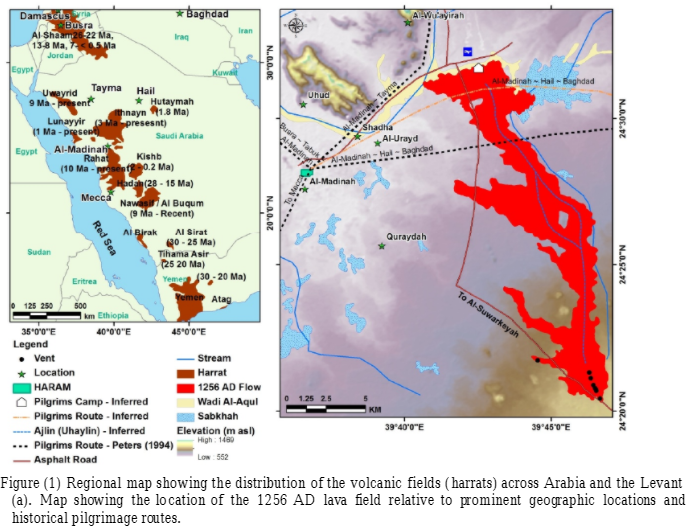
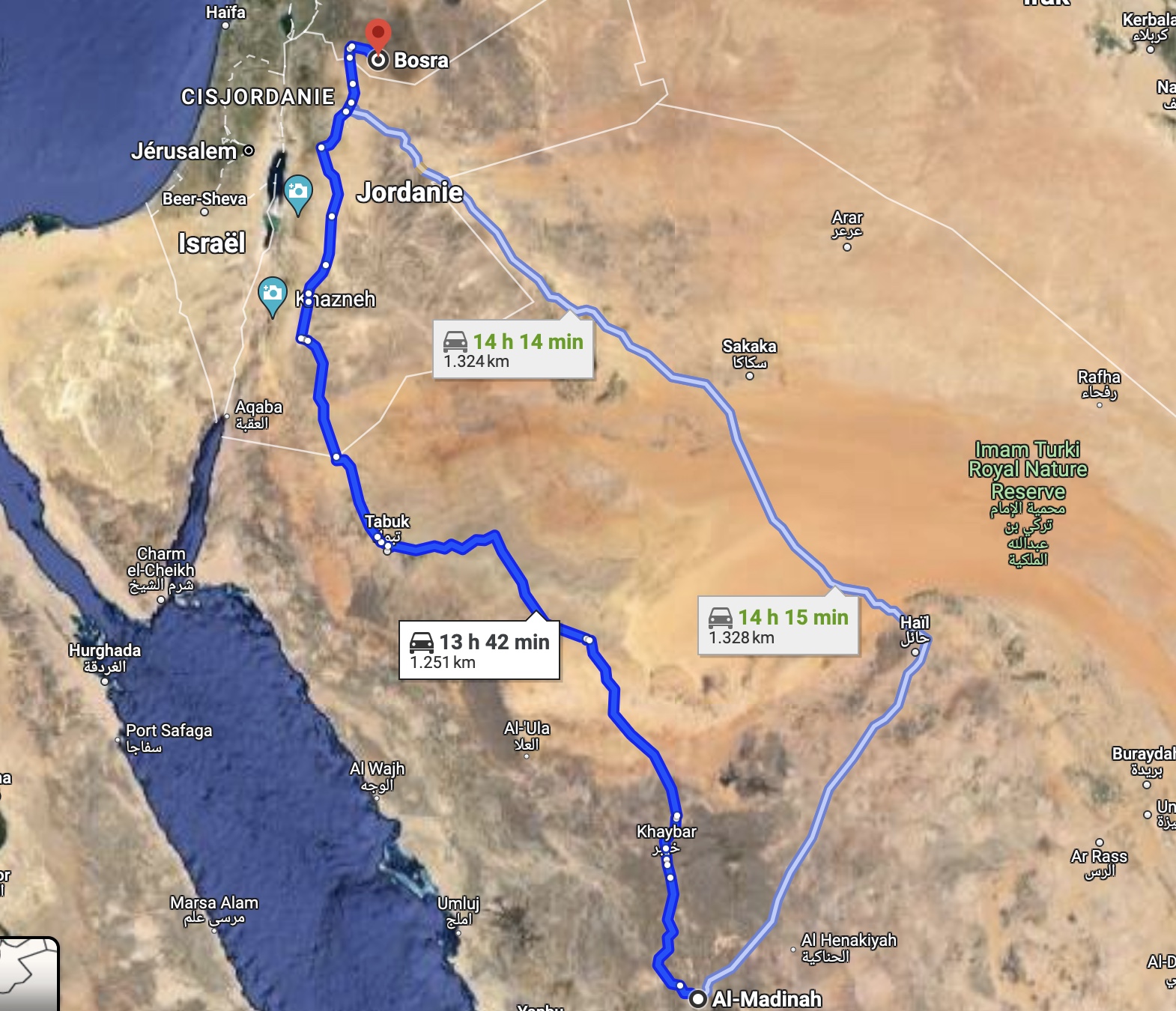
This event happened in 1256, precisely as described by Prophet Muhammad(ﷺ); lava fields around Medina can still be seen today.
Ḥarrat Rahāṭ[1] (Arabic: حَرَّة رَهَاط) is a volcanic lava field in the Hejazi region of Saudi Arabia. In 1256 CE, a 0.5 km3 (0.12 cu mi) lava flow erupted from six aligned scoria cones, and traveled 23 km (14 mi) to within 4 km (2.5 mi) of the Islamic holy city of Medina; this was its last eruption. There were earlier eruptions, such as in 641 CE, which made finger-like flows to the east of the 1256 CE flow.[2] It is the biggest lava field in Saudi Arabia.[3] Nearby is Al Wahbah crater.
https://en.wikipedia.org/wiki/Harrat_Rahat
The great historian, Abu Shāma ( died 1267 ), experienced it first-hand and documented many of its details, including its visibility from hundreds of kilometers away and how the people of Medina sought refuge in tProphet’st’s mosque and collectively repented of the vices in which they had indulged.
According to Al-Qastallani the night the fire was erupted, its light was sighted in Tayma in the north and as far north as Busra in Syria (about 940 km away from Al-Madinah). Travelers reported that they could see the light of the fire as far as a three-day walk away. He also noted that the light of the moon diminished next to the light of the fire
https://www.researchgate.net/publication/259043951_Historical_Accounts_of_the_AD_1256_Eruption_near_Al-Madinah.
Here is a summary of this multifaced prophecy :
- Prophecy: A fire would emit from the Hejaz region.
- Fulfillment: A volcano erupted in the Hejaz region.
- Prophecy: The fire would come from the Earth.
- Fulfillment: Lava, which originates from the Earth, was the source.
- Prophecy: The fire would illuminate Busra, a city hundreds of kilometers away.
- Fulfillment: The fire illuminated Busra, just as predicted.
The exact realization of a prophecy from over a thousand years ago cannot be chalked up to mere chance; it is a divine indication meant for all humanity. Surrounded by individuals who were unaware of even volcanic activity, an uneducated man-made predictions about this event. The fact that his precise prophecy came to pass centuries later clearly indicates that this is not merely the doing of an ordinary person but of a genuine prophet.
the Prophet (ﷺ) predicts Arabia will become plains and rivers, Starting to be Fulfilled 1392 years after the death of the Prophet (ﷺ)
Today, we only know Arabia as an arid desert, which was also the case at the time of the Prophet (ﷺ)and thousands of years before the Prophet ﷺ. The following Hadith, however, brings a new perspective on the green history and the future of Arabia :
This prophecy includes two parts:
- Past: Arabia used to be filled with plains and rivers.
- Future: It’s predicted that Arabia will return to being plains and rivers again.

In a study published in September 2021, researchers found evidence that the Arabian Peninsula once had a very different landscape. They analyzed sediment samples from ancient lakes and examined the remains of hippos and other animals. This revealed that the region had lakes and grasslands year-round at several points in the distant past. The findings about hippos were especially significant. Hippos require deep water bodies to survive throughout the year, offering strong proof that what is now a dry desert was once lush and teeming with animal life. Michael Petraglia, a Paleolithic archaeologist at the Max Planck Institute for the Science of Human History in Jena, Germany, explained :
“Flowing rivers and lakes, surrounded by grasslands and savannahs, must have attracted animals, and then the first humans who sought them out.”
Washignton post :Prehistoric Arabia was actually lush and green
In the future, there are two possible scenarios for this prediction to come true, and both suggest it will indeed happen :
- The Arabian Peninsula could experience a greening phase again due to meteorological conditions driven by climate change and shifts in monsoon patterns. As global temperatures rise, alterations in sea surface temperatures and atmospheric circulation could enhance monsoon systems, directing more rainfall toward the region. Additionally, if future climatic conditions align similarly to past wet phases, influenced by factors such as Milankovitch cycles—variations in Earth’s orbit and tilt—this could lead to increased rainfall. Such meteorological shifts would not only bolster plant growth and transform arid landscapes but could also influence the overall ecosystem, leading to a greener, more biodiverse Arabian Peninsula. In recent years, the Arabian Peninsula has been experiencing significant rainfall, leading to dramatic changes in its typically arid landscape. :
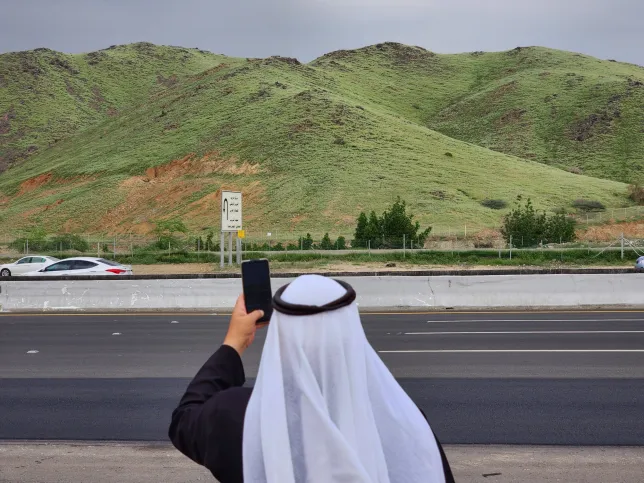
. :https://metro.co.uk/2023/01/17/saudi-arabian-desert-turns-green-after-weeks-of-rain-18115534/
- The second possibility is linked to ongoing initiatives, such as afforestation projects and the development of sustainable agricultural practices aimed at greening deserts. Countries like Saudi Arabia and the United Arab Emirates have invested in large-scale projects to plant trees and create green spaces, which, aside from aiming to combat desertification, also serve to improve local climates and ecosystems, satellite images taken by NASA between 1987 and 2012 show a noticeable increase in greenery in some regions of Arabia, illustrating the impact of these irrigation efforts :
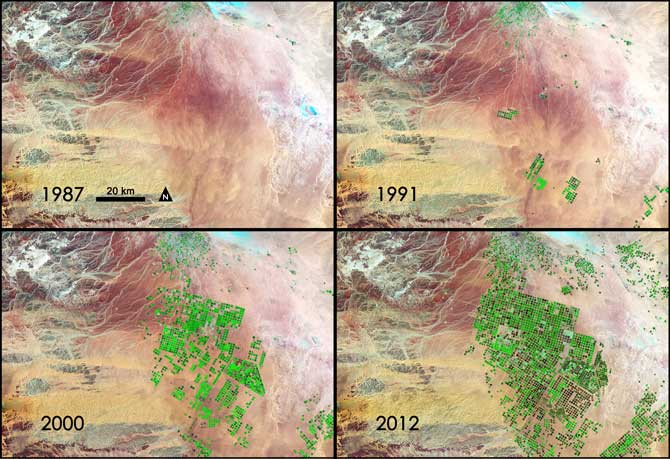
The Prophet (ﷺ) foretells the sudden appearance of high towers in Arabia
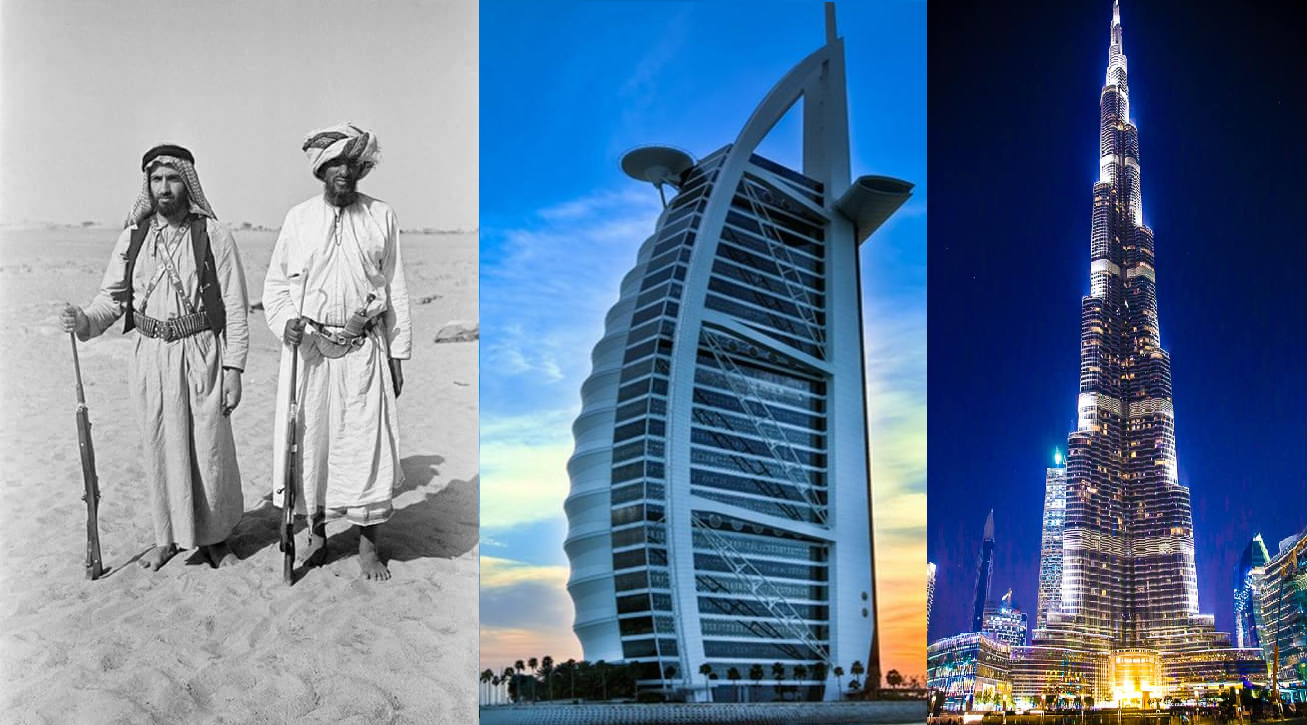
When the Prophet (ﷺ) Muhammad(ﷺ) was asked about the signs of the end times, he mentioned a surprising scene:
When asked to elaborate further, the Prophet (ﷺ) said that they are from the Arabs. (Musnad Ahmad bin Hambal Hadith #2924 )
Imagine these nomads, who for centuries roamed the harsh Arabian deserts. Up until the 1970s, life for the Bedouins was about survival, dependent on unpredictable rains and avoiding raiders. In his 1945 book “Arabian Sands,” Sir Wilfred Thesiger captured their life, which was governed by fate and harsh desert elements. Even a documentary from the 1970s shows that life in Abu Dhabi back then was like stepping back into biblical times.
Now, fast forward to today, and it’s a whole different story. Areas like the UAE, where Bedouins were the majority just 40 years ago, are now filled with skyscrapers, including the world’s tallest building, the Burj Khalifa. This transformation from simple desert life to leading a global architectural race happened in just a few decades.
The competition aspect described by Prophet Muhammad(ﷺ) can be observed in the ongoing announcements of new projects aimed at building the world’s tallest skyscrapers. For example, Saudi Arabia announced the construction of the Jeddah Tower, which will exceed 1,000 meters in height, and the Emirates announced the Dubai Creek Tower, set to surpass 1,300 meters. This race to construct ever-taller buildings among the Bedouins aligns precisely with how the Prophet (ﷺ) described their competitive nature.
Those very Bedouins who lived day-to-day would one day compete in building the tallest skyscrapers. This seemed like an impossible prediction at the time—why would anyone think that these impoverished nomads could turn into wealthy city-builders?
The precision of this prophecy is striking, and the transformation of the Bedouins from a life of hardship to luxury is nothing short of incredible. It’s a real-life story of going from rags to riches, happening within just one generation. The dramatic shift from desert tents to towering skyscrapers not only fulfills an ancient prophecy but also showcases one of the most extraordinary transformations in modern history.
Prophecies about specific persons
Prophet Muhammad(ﷺ) made specific prophecies concerning his companions and other individuals who lived during his time. These prophecies often detailed the roles they would play, their destinies, or significant events they would witness or participate in.
The Bold Prophecies Concerning Abu Lahab: fulfilled in the life of Prophet Muhammad (ﷺ)
After three years of calling upon Allah in secret, the Prophet Muhammad (ﷺ) received the order to carry out his mission openly; when the whole tribe of Quraysh gathered around him, the Messenger of Allah (ﷺ) called each clan by name and said to them: “If I tell you that behind this hill is an enemy army preparing to attack you this morning or by this evening at the latest, will you believe me?” They all replied with one voice: “We have never heard you tell a lie.” the Prophet (ﷺ) said: “Then I warn you against a punishment as terrible as it is imminent.”
His uncle Abu Lahab stood up before anyone could flinch and said: “May you perish this day! You brought us here to make us hear such a thing!” In his defense, God immediately revealed:
The Rationality Behind the Prophecy
- Specific Mention in the Quran: The verses specifically mentioned Abu Lahab by name and his wife, who were alive at the time.
- No Conditional Statement: The verse did not say “unless they repent”; it outright declared that they will burn in hellfire because they are disbelievers (kuffar).
- Possibility of Conversion: Abu Lahab’s conversion to Islam was theoretically possible. His brother had already become a Muslim, and his nieces had also embraced Islam. Even Omar Ibn El Khattab, who was initially more hateful towards Islam than Abu Lahab, became a Muslim. Therefore, declaring that Abu Lahab would die as a disbeliever is something no rational person would do unless they were sure of their source of information.
- High Risk of Error: Given that all of the Prophet’s enemies were waiting for his one mistake to disprove his prophecy, making such a bold declaration was extremely risky. Abu Lahab could have simply declared himself a Muslim to debunk Islam, especially considering his strong hatred for it.
It is astonishing that for the next nine years of Abu Lahab’s life, despite hearing these verses being recited, his pride prevented him from using them as an opportunity to discredit the Quran. His hatred for Islam could have driven him to declare himself a Muslim just to invalidate the prophecy, yet he never did so.
Abu Lahab had four sons, two of whom died at a young age during his lifetime. The other two sons and a daughter embraced Islam, frustrating his hopes. He died in a state of disbelief of a plague; people would not touch his body out of fear of contamination and dumped mud and stones on him where he died to make it his grave.
The prophecy concerning Abu Lahab is a profound example of the Quran’s divine knowledge. Despite the risk and the obvious opportunity for Abu Lahab to disprove the prophecy by simply declaring himself a Muslim, he never did. This unwavering accuracy underscores the Quran’s truthfulness and the certainty of the Prophet Muhammad (ﷺ) in the divine revelation he received. It also illustrates the miraculous nature of the Quran as it confidently predicted events that were beyond human foresight.
The locations and names of the fallen at the Battle of Badr: fulfilled in the life of Prophet Muhammad (ﷺ)
As stated in this Hadith by Mouslim, Before the decisive Battle of Badr, Prophet Muhammad (ﷺ) walked the battlefield with at least one of his companions. As they moved across the field, he pointed to specific locations and said, “This is the place where so-and-so will be killed,” naming individuals who would fall there. After the battle concluded, the companion observed that the soldiers named by the Prophet (ﷺ) indeed lay dead in the exact spots he had indicated. This event is often cited as a remarkable testament to his prophetic insight.
The fate of a man who seemed to be a believer: fulfilled in the life of Prophet Muhammad (ﷺ)
Fatima will be the first of the Prophet’s (ﷺ) family to pass away after him: fulfilled 6 months after the death of Prophet Muhammad (ﷺ)
The Prophet (ﷺ) predicts which of his wives will be the first to die: fulfilled 9 Years after the death of Prophet Muhammad (ﷺ)
the Prophet (ﷺ) foretold the conquest by sea and predicted that Umm Haram bint Milhan would be among them: fulfilled 16 years after the death of Prophet Muhammad (ﷺ)
Um Haram participated in the first Muslim naval expedition under the Caliphate of Mu’awiyah, marking a significant event in Islamic history. However, she died shortly after this expedition and did not live to witness or partake in the subsequent conquest of Constantinople.
Ibn Hajar noted, “This contains multiple prophecies by the Prophet (ﷺ) of what would take place, and it all occurred just as he said, which is considered among the signs of his prophethood.
Among these prophecies was that his nation would endure after him, and among them would be those who are strong, formidable and a consequential force against the enemy. It was foretold that they [the Muslims] would conquer territories and command the sea, that Um Haram would live to see this era, that she would be part of the army that rides the sea, and that she would not survive to participate in the second military campaign to Constantinople.”
The transgression party will kill Ammar ibn Yasser, and his last meal will be milk: fulfilled 25 Years after the death of Prophet Muhammad (ﷺ)
The battle of Ṣiffīn, which occurred about three decades after Prophet Muhammad(ﷺ) ‘s (ﷺ) death, saw the fulfillment of a poignant prophecy involving ‘Ammār ibn Yasir (RA). Prophet Muhammad (ﷺ) had prophesied that ‘Ammār would be killed by the “transgressing party,” a prediction that materialized during this conflict. ‘Ammār was killed by the forces of Shām, who were led by Mu’awiya ibn Abi Sufyan and were opposing the rule of Caliph Ali, whom they blamed for the chaos following the murder of Caliph Uthman :
Finally, moments before the battle of Ṣiffīn, as a glass of milk was passed to ‘Ammār (RA), he smiled and said, “The Prophet ﷺ told me that the last thing I would drink before I died would be milk.” [ Aḥmad (18782, 18785), and al-Ḥākim (3/389) ] Then he stood up to keep his Prophet ﷺ’s promise and fought until he died.
The Prophet predicted that Hasan bin Ali would reconcile two major warring Muslim groups: fulfilled 29 Years after the death of Prophet Muhammad (ﷺ)
The Prophet (ﷺ) predicted that Hasan bin Ali would reconcile two major warring Muslim groups. After his father’s assassination, Al-Hassan ibn Ali became the Caliph, holding the position for six months and a few days. Then, Muawiyah ibn Abi Sufyan mobilized a large force against him. In response, Al-Hassan, may Allah be pleased with him, sent him a message to relinquish the caliphate in his favor.
He did this to prevent a great massacre among Muslims, thereby fulfilling the Prophet’s (ﷺ) prophecy. The Prophet (ﷺ) had once said, while on his minbar with a young Al-Hassan by his side, occasionally glancing at the people and then at him:
He ended their dispute by renouncing the caliphate in favor of Mu’awiyah (may Allah be pleased with him) in the year 40 or 41 of the Hegira, which was called “the year of the gathering.” This was a year in which bloodshed was spared, and Muslims were reunited.
Al-Mukhtar al-Thaqafi: the liar of the Thaqif tribe: fulfilled 53 Years after the death of Prophet Muhammad (ﷺ)
The prophecy mentioned by Prophet Muhammad (ﷺ) about a great liar emerging from the Thaqif tribe points directly to al-Mukhtar al-Thaqafi, according to historical accounts. Al-Mukhtar was known for his cunning and deceit. Initially, he deceived many by gathering a following, later escalating his claims to suggest that the angel Gabriel was bringing him revelations.
Eventually, al-Mukhtar audaciously proclaimed himself a prophet, misleading many. His deceptive practices led to significant turmoil within the Muslim community and gave rise to the Kaysaniyya sect. Despite his notorious history of deceit, some factions, particularly within the Shia community, view al-Mukhtar positively, attributing to him a status that overlooks his actions against the foundational tenets of Islam. His legacy is a complex one, reflecting the divisive impact of his claims and the long-lasting influence of his deceit.
Hajjaj Ibn Yousuf, the great murderer of the Thaqif tribe: fulfilled 73 Years after the death of Prophet Muhammad (ﷺ)
One of the Prophet Muhammad(ﷺ) companions, Abdullah ibn Zubair, was crucified on the road from Medina to Mecca by the tyrannical ruler Hajjaj ibn Yusuf, who was of the Thaqafi tribe and notorious for his brutality towards many companions. After his death, in a final act of insult, Zubair’s corpse was thrown into the graveyard of the Jews. Proud of his actions, Hajjaj summoned Zubair’s mother, Asma’, to meet with him. She repeatedly refused, bruising his ego, so he went to her instead.
When Hajjaj confronted her, boasting, “What do you think of what I’ve done to the enemy of Allah?” she responded, “I think that you’ve destroyed his worldly life and destroyed your own afterlife.” She then recounted a prophecy she had heard from the Prophet (ﷺ), stating, “The Prophet told us that from Thaqif, there would be born a great liar and a great murderer. The liar we have seen, and as far as the murderer is concerned, I do not find anyone else besides you.” Taken aback by her words, Hajjaj left without a response. (See Hadith in sahih Mouslim)
Prophecies about the rise of sects and false Prophet
The Prophet announces the coming of false prophets
Prophet Muhammad(ﷺ) said he was the Prophet (ﷺ), as also stated in the Quran :
Despite this, there have been several individuals within the Muslim world who have claimed prophethood, leading to significant religious debates and conflicts, exactly how the Prophet described it, for example :
- Musaylimah the Liar – Emerging during the time of Prophet Muhammad(ﷺ), Musaylimah claimed to be a prophet himself. His claim led to a direct confrontation with the early Muslim community, resulting in the bloody Battle of Yamama, where many lives were lost.
- Mukhtar al-Thaqafi – Claiming to be the representative of a Shia Imam, Mukhtar led a rebellion that caused much bloodshed during the Second Fitna, a period of intense civil war within the Islamic community.
- Bahá’u’lláhh – In the 19th century, Bahá’u’lláhh, born in Persia (modern-day Iran), founded theBahá’ííFaithh. He declared himself a prophet, which he claimed was in fulfillment of Bábísm prophecies, but went further to assert that he was bringing new divine revelations.
- Mirza Ghulam Ahmad founded the Ahmadiyya movement in late 19th-century India. He claimed to be the Mahdi and the Messiah, a continuation of Muhammad(ﷺ)’s prophetic mission. This has led to considerable controversy and widespread rejection by mainstream Sunni and Shia Muslims, who consider him a false prophet. His followers are officially declared non-Muslims.
Prophecy about the Quranist sect
Quranists, a group that refers to themselves by this name, entirely dismiss the Sunnah, Hadith, and, by extension, the Prophet Muhammad(ﷺ) himself, which contradicts the fundamental Islamic belief in Allah and the Prophet as His final messenger. Interestingly, the Hadith predicted the emergence of such a group over 1400 years ago. This movement, resembling a diluted form of agnosticism, represents a modern deviation that could potentially lead to the eventual rejection of the Quran itself.
Prophet Muhammad(ﷺ) predicted the emergence of the extremist Sect of Khawarij and modern-day ISIS.
In Multiple Hadiths (bukhari:7562,bukhari:6934,bukhari:5058), The Prophet Muhammad(ﷺ) predicted the emergence of extremism within the Muslim community in the form of the Kharijites—the first extremist faction in Islamic history. The Kharijites originated during the leadership of the fourth Caliph, Ali bin Abi Talib. They were followers of Ali who later rebelled against him during a civil war in Siffin in 658, rejecting arbitration and accusing Ali of apostasy. The group emphasized strict, literal interpretations of the Quran and practiced takfir, declaring other Muslims disbelievers a stance that justified their extreme actions, including violence against those they considered apostates.
Ali’s initial tolerance toward the Kharijites ended when they brutally killed a companion of the Prophet and his wife. This prompted Ali to confront and defeat them in the Battle of Nahrawan. The Kharijites left behind a legacy of extreme ideology, characterized by a superficial understanding of Islam and a rejection of scholarly interpretations. Their outward display of piety contrasted sharply with their harsh actions. The Prophet (ﷺ) described such extremists as appearing religious yet lacking a deep understanding; their Faith was shallow.
In another hadith, Prophet Muhammad(ﷺ) said that this sect would continue to emerge and then be destroyed until the end of time ( ibnmajah:174); modern extremist groups ISIS share many traits with the Kharijites, including the practice of takfir, a rigid interpretation of Islam, and a narrow, literal understanding of religious texts who will recite the Quran but it will not exceed their throats.
These groups attract young followers who, despite a superficial adherence to Islamic practices and propagation, often possess a limited understanding of the religion. This continuity of extremist ideology from the Kharijites to contemporary groups underscores the ongoing relevance of the Prophet’s warnings about such factions within the Muslim community. These historical and modern parallels offer insights into dealing with and understanding the phenomenon of religious extremism in Islam.
Prophecies about Major Events to come
The Plague Of Amwas: fulfilled 5 years after the death of Prophet Muhammad (ﷺ)
In the following Hadith, Prophet Muhammad(ﷺ) made several precise prophecies about what will happen after his death :
In 638 AD, a devastating outbreak known as the “Plague of Amwas” or the” “Plague of Emwas” ravaged the Muslim population in Syria, resulting in tens of thousands of deaths. This occurred during the rule of Umar ibn Al-Khattab.
An increase of wealth amongst the Muslims: fulfilled 13 Years afProphet Prophet Muhammad (ﷺ)
During Uthman’s leadership, the Muslim empire expanded rapidly through continued conquests, bringing significant wealth and fulfilling the prophecy. However, some scholars believe this increase in wealth among the Muslims occurred during the rule of Umar ibn Abdul Aziz.
The Fitna in Arabia: fulfilled 24 Years after Prophet Muhammad (ﷺ)
Prophet ﷺ described A massive affliction that no Arab home would escape it is the fitna that happened. After the assassination of Caliph Uthman in 656 AD, chaos spread across all of Arabia, affecting every Arab household. This turmoil eventually led to the conflict between Mu’awiyahah and Ali, resulting in extensive bloodshed. The affliction and unrest continued for several years thereafter.
As for the Byzantine truce and scourge, scholars seem to agree that this is a prophecy about the end of times.
The caliphate will last for thirty years; then, there will be a monarchy.
Following the Prophet’s passing, Abu Bakr assumed leadership and ruled for approximately two years, followed by Umar for ten years, Uthman for twelve years, and Ali for about five years. After Ali’s tenure, his son Hassan briefly assumed the caliphate before ceding leadership to Mu’awiyahah, marking the beginning of the Umayyad dynasty.
Safinah, a companion of the Prophet (ﷺ) and the narrator of this Hadith (tirmidhi:222) discussed this prophecy with Sa’idd, instructing him to count the years of each Caliph’s rule starting from Abu Bakr, then Umar, Uthman, and finally Ali. Sa’idd found that, collectively, their reigns totaled precisely thirty years, as the Prophet (ﷺ) had foretold.
Conclusion
The prophecies made by false prophets typically exhibit a notable vagueness, serving a strategic purpose. This ambiguity allows their followers to readily identify events that could ostensibly validate the prophecies, as almost any occurrence might loosely align with such broad predictions. This phenomenon is grounded in the probability that, given enough time, something will transpire somewhere that appears to fulfill the prophecy, lending it illusory accuracy.
Contrastingly, the prophecies of Prophet Muhammad(ﷺ), as outlined in this article, are characterized by their specificity, precision, and often counterintuitive nature. Unlike the generic foretellings of false prophets, Muhammad(ﷺ)’ss prophecies provided detailed insights that were not easily deduced or predicted by common knowledge at the time. This level of detail in his prophecies points to a deeper, more informed source of knowledge.
Such distinct clarity and unexpected accuracy in Muhammad(ﷺ)’ss prophecies are undeniable proof that these prophecies originated from the Creator of the heavens and the Earth, distinguishing them markedly from the ambiguous predictions of false prophets. This specificity not only reinforces the Faith of believers but also challenges the skeptics to reconsider the origins of such profound foreknowledge.


